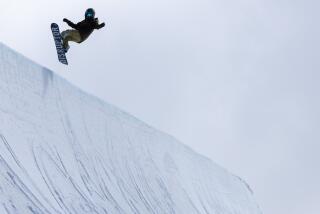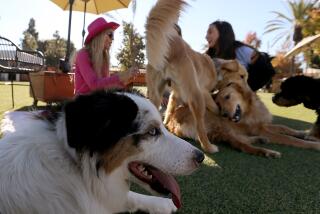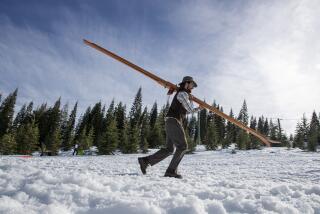Pooch Pulls, Skier Pushes in Ski Sport That’s Growing in Popularity
BEND, Ore. — On a snow-covered trail in Oregon’s Cascade Mountains, Bob Crain snaps into his cross-country skis, hooks a rope and harness to Buster, his chocolate Labrador retriever, and hollers, “Hike!”
And off they go.
For about five yards. Buster comes to a sudden stop. He barks at Crain. He rolls in the snow. He gets up and wags his tail. Then Buster circles his master--until the rope is tangled around Crain’s legs.
Crain, 50, has discovered the perfect winter sport to keep him and his pet in shape, if only Buster would cooperate.
Skijoring, Norwegian for snow driving, is becoming the winter sport of choice for a growing number of people, like Crain, who want to bond with their dogs. But getting a dog to pull while the skier pushes usually requires a few clinics, steady practice and, in some cases, a bribe or two.
“As long as he thinks there’s a snowball in it for him, he’ll go,” said Crain, who tosses pine cones and snowballs for Buster to chase down the trails.
Skijoring (pronounced SKEE-johr-ing) came to this country with Scandinavian immigrants, but only in the last year has it caught on. The International Federation of Sleddog Sports has recognized skijoring as a competitive sport. And weekend clinics and “fun runs” have introduced more dogs to trails once dominated by Nordic skiers and snowmobiles.
“It gets in your blood,” said 46-year-old Dina McClure of Sisters, who has been instrumental in introducing skijoring to central Oregon.
The idea is that the dog and skier do an equal amount of work. The cross-country skier pumps down the trail, and gets extra speed from being pulled by a dog. Imagine dog sledding without the burden of a sled.
Traditionally, Northern-bred dogs like Malamutes have been used to skijor. But these days, dogs of all kinds are used, even poodles and mutts. Amateur skijorers say it’s the closeness that develops between dog and skier that keeps them coming back for more.
“It’s unlike anything you’ve ever been through before,” said Bob Brock of the North American Skijoring and Ski Pulk Assn. in Anchorage, Alaska.
His dog has a competitive streak and expects the same from his owner.
“When we’re racing, if I’m not cutting it, my dog will turn around, as if to say, ‘What are you doing?’ ” Brock said.
Although the sport is practiced worldwide--in Australia skijorers use scooters instead of skis--purists rely on snow, skis and one to three dogs.
In this country, that means most skijoring happens in cold places such as Alaska, the sport’s unofficial home base, some Northeastern states, the Midwest and the Cascades.
McClure moved from Alaska to Oregon 11 years ago, to be close to Mt. Bachelor and its miles of snow trails.
She founded the Cascade Skijor Alliance, a Bend-based association dedicated to promoting the sport, competitively and recreationally. She helped one business, Critter Creations of Oregon, incorporate skijoring equipment in its inventory. And she founded her own company, Skijoring Outfitters.
It wasn’t until this year, however, when McClure was asked to teach a skijoring workshop through Central Oregon Community College, that she realized the sport was gaining wider acceptance.
“It’s an affordable sport you can do with your dog,” said McClure, whose skijoring group has 50 members. “But it’s far from reaching its peak.”
To get started, skijorers need dogs that weigh at least 40 pounds. They also need about $100 worth of equipment--including skis, poles, a dog harness, belt and a towline with a built-in shock cord for the dog.
And, of course, they need a good attitude.
McClure encourages people to take classes, to learn how to evaluate their skiing skills and their dog’s abilities. She emphasizes the importance of dog care and trail etiquette.
She also encourages participation in weekend “fun runs,” where beginners, like Crain and Buster, can learn from advanced skijorers and their dogs.
On a Saturday morning, about a dozen skijorers arrive at the mouth of a tree-lined trail at 9 a.m. Socializing begins immediately--for the dogs, that is. Meanwhile, owners ensure that everything is set up to make the animals as comfortable as possible.
McClure sets up a line between two trees, which serves as a sort of hitching post for the dogs to rest before and after runs. Next to the line, she sets water bowls and a bag of biscuits. Once her dogs are hooked up, she checks the trail--paws need booties if it’s too icy--and gets herself ready.
Dogs come before skiers in this sport. Two hours before McClure arrives at the trail, she feeds, waters and walks her pets. Competitive skiers treat dogs like athletes, giving them broth to clean out the digestive system before a big race.
“You want to try and get the timing down right so the dog can be as comfortable as possible,” said Blaine Florance of Bend, who skijors competitively. This helps skiers avoid “packing poop”--cleaning dog droppings off the trail.
After setup, everyone begins to do their own thing.
Florance, the most experienced, takes off for a six-mile run with his dogs. McClure goes out with hers, but they’re not in the mood, so she heads back.
Beginner Ed Lavery, 52, of Sun River doesn’t even bother to put on skis. He spends the morning teaching his dog, Seven, to pull plastic jugs filled with water.
“We’re starting out slowly,” said Lavery.
More to Read
Sign up for The Wild
We’ll help you find the best places to hike, bike and run, as well as the perfect silent spots for meditation and yoga.
You may occasionally receive promotional content from the Los Angeles Times.






